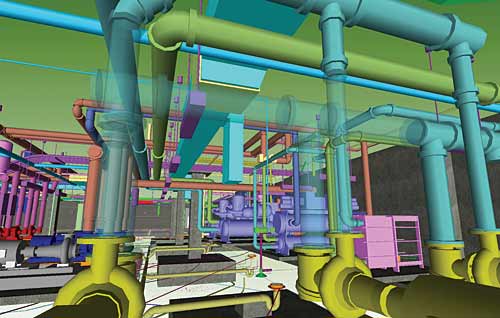Integrated BIM and Design Review for Safer, Better Buildings
Field Experience on Safety and Sustainability
The focus on HSW considerations has led to some unique advances in the field. Among many authorities having jurisdiction (AHJs), for example, BIM and integrated design review are improving how codes officials handle building inspections, permitting processes, and design and zoning reviews. The Singapore government, for example, now requires all building permit applications to be submitted in a software format that allows for automatic code checking.
The idea is nascent in the United States, with serious attention from the International Code Council (ICC). The group's "SMARTcodes" initiative envisages instant plan reviews and reduced approval cycles. According to ICC, an "automated code-compliance check" employs BIM data and model-checking software. Codes officials may print the results or view the building design in 3-D, with any noncompliant elements highlighted with explanations of the violations. David Conover, ICC senior advisor, adds that the technology allows "interoperable building regulations" to be cross-referenced through BIM, showing whether the designs meet all life-safety and ADA rules. The output could include "redlining" of, for example, non-fire-rated penetrations in fire-resistive walls.
|
|||
Another benefit would be instant public availability of information on the building, site access, and any storage of hazardous materials for use by the fire service in disaster planning and response.
Based on interoperable BIM technology, SMARTcodes is similar to the collaborative design review tools. Many of the benefits are alike, too, says the ICC: "By automating and sharing data, building departments can reduce the time it takes to review plans and increase code compliance, allowing staff resources to be shifted to the field to perform enhanced building inspections. Designers and others in the building community can also address code-related issues more completely and accurately prior to permit submittal," said a recent statement by the group.
While few U.S. jurisdictions have adopted such a process, more AHJs are conducting automated energy analyses, such as with REScheck or COMcheck. Building project teams are much farther along, using BIM for simulations of building performance - for example, ensuring ample daylight and view corridors, analyzing provisions for users with disabilities, or studying life-safety egress.
Another growing trend is the use of BIM to boost building performance and sustainability. In the BIM models, design features and specifications describe quantitative performance attributes, such as for VOC content, energy consumption, reflectivity or solar gain. This gives the A/E team insights into the best orientation and enclosure strategies, as well as layouts and materials that best support occupant health and welfare.
At the end of design, BIM supports A/E firms in the submittal of required drawings and documentation for LEED® certification. Quantification of recycled or recyclable material contents, determination of life-cycle costing, as well as the modeling of energy and daylighting effects can all be accomplished more quickly. According to architect Jim Gleeson, AIA, BIM can be used to "link project information directly to a Web-based MasterSpec LEED specification" or to quantify material content or the recycled content in fixtures and furnishings. The design model can also be linked to such energy-modeling programs as the Lawrence Berkeley National Laboratory's DOE-2.
According to Martin Fischer, director of Stanford University's Center for Integrated Facility Engineering, building owners and users can expect improved life-cycle performance when a model is shared among mechanical engineers and others. Fischer has shown that research labs designed using this process have heating energy requirements as low as 20-25 kilowatt-hours per cubic meter, compared to levels two to four times higher for facilities not using BIM.
"Building performance can be tracked within the 3-D space," says Boryslawski. "One can calculate heat gains or losses and observe the movement of hot and cold air in a form of red and blue 3-D cloud moving" in a BIM model simulation, he explains.
In some cases, collaborative BIM has been effective in evaluating specific user health targets as desired by owners or by LEED® project certification. For the Georgia State University Library, for example, BIM load calculators and design tools enabled the study of shading, shadow locations, and daylight penetration within occupied spaces. (The construction manager also used the data to do cost takeoffs for proposed design alternatives.) BIM was also effective in the team's elevation studies, undertaken to describe views of the plaza from the interior based on various fenestration designs.
Similarly, simulations for the GSA's Herbert C. Hoover Building in Washington, D.C., helped redesign an infill structure within the building's courtyard. The solution included the effects of a green roof and skylight, showing where daylight and cooling or heating needs would change. For the nearby White House Visitor Center and Law Library, BIM modeling allowed the project team to keep ceilings as high as possible, introduce maximum daylight, and integrate new supply-air distribution, all enhancing the indoor environmental quality, or IEQ. The model also helped to determine the needed life-safety egress and to reduce the project's impact on historic facilities.
For the Eisenhower Executive Office Building, Washington, D.C., in order to address historic guidelines, as well as to ensure security objectives were met, the project team used BIM and a digitized video file to ensure compliance for a rehabilitation introducing new glazing. The results demonstrated the quantity and quality of daylight as well as the impact of shadows, while ensuring preservation and security objectives.










